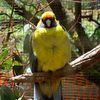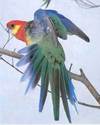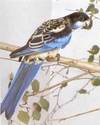Genus Platycercus

Pale-headed Rosella - Found in open woodland, it feeds on seeds and fruit. As with other rosellas, the Pale-headed Rosella nests in hollows of large trees. It readily adapts to aviculture and is sold as a cagebird.
Green Rosella - The Green Rosella was described by the German naturalist Johann Friedrich Gmelin in 1788. The species specific epithet was derived from the mistaken belief the bird was collected from New Caledonia.
Crimson Rosella - Though described by Johann Friedrich Gmelin in Systema Naturae as Psittacus elegans in 1788, the Crimson Rosella had been described and named by John Latham in 1781 as the Beautiful Lory, and then Pennantian Parrot. However he didn't give it a Latin name until 1790, when he named it Psittacus pennanti. In 1854, it was placed in the genus Platycercus by Martin Lichtenstein in his Nomenclator Avium Musei Zoologici Berolinensis.
Eastern Rosella - The Eastern Rosella was named by George Shaw in 1792. It is sometimes considered a subspecies of the Pale-headed Rosella . The term White-cheeked Rosella has been used for a species or superspecies combining the Pale-headed and Eastern forms.
Western Rosella - Western Rosellas socialise in pairs but will often congregate in largish groups of twenty or so to forage when the season permits; their diet is herbivorous, consisting mostly of grass and seeds. They nest mostly in hollow tree trunks usually a meter or so deep and will favour hollows that have dust in the bottom . The female incubates the eggs and leaves in the morning and afternoon to eat food found by the male.
Northern Rosella - At 28 cm long it is smaller than all bar the Western Rosella. The forehead, crown and nape are black in colour with white-on-blue cheek-patches. The back and wing feathers are blackish with yellow borders, while the feathers of the belly, chest and rump are pale yellow with black borders giving rise to a scalloped appearance. The long tail is bluish green. The beak is pale grey and the iris dark. Immature plumage is similar to adult but duller.






